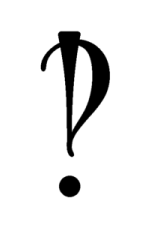- Apostrophe
- Brackets-which include: braces, parentheses, angle brackets, and square brackets
- Colon
- Comma-comes from the Greek Word "Komma" which means "something cut off" or "a short clause"
- Dash-includes: en dash (used in a closed range of numbers i.e. 1943-1956), em dash (is one em in width; used like this "John Doe, 1987-"
- Ellipsis (Ellipses. pl.) ... or *** indicates omission of text
- Exclamation Point- also known as the screamer, bang, or mark of admiration. Probably originated from the Latin word for joy, io. You could see how that came about
- Full Stop- also identified as the period, full point, or dot
- Hyphen-different from dash, it serves to denote syllabification ie "syl-lab-i-fi-ca-tion".
- Question Mark
- Quotation Mark- also referred to as quotes, guillemots, and inverted commas
- Semicolon
- Slash- also named Solidus/Diagonals/Separatrix/Shilling Mark/ Stroke/ Virgule
- ***Tricky One*** The Space!!- though not technically a written symbol, it still clearly serves to organize and clarify Latin script writing. Did you know that the ancient Latin and Greek was written without any spaces. It wasn't until 600-800 AD that they incorporated spaces in their languages. AMAZING!!!
**extra credit if you knew about the INTERROBANG!!!!It's not often used today, but an interrobang asks a question in an excited manner. Appropriate that it's name appears to be a conjugation of Interrogate and BANG! Here's a picture of one(in case you've never seen one, just like me)

Music for the day:
How Soon Is Now-The Smiths/Dictionaraoke(mp3)
The Laughing Crowd-Ron Sexsmith(real/windows)
No comments:
Post a Comment